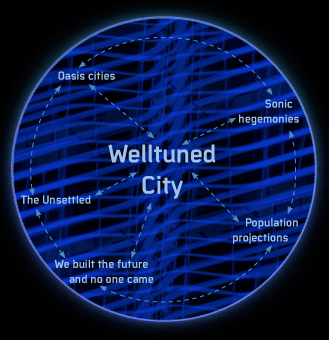Sonic hegemonies
“Any kind of control is in danger of being controlling. It’s one thing to control your own environment, but what if someone decides to control it for you. For example when you come into George Street, Sydney [and someone has decided] you might just like to hear sparrows. Who the hell wants that? That’s one of the challenges for design, how do you make a design that somehow reflects a community, not just one person’s idea. Sound is so political — as soon as you start to control it, you’re making a very big political move.”
Cat Hope, Australian sound artist/composer [1]
Back in the 1960s Canadian acoustic ecologist R. Murray Schafer called for a tuning of the world. He asked “Which sounds do we want to preserve, encourage, multiply? When we know this the boring or destructive sounds will be conspicuous enough and we will know why we must eliminate them. Only a total appreciation of the acoustic environment will give us the resources for improving the orchestration of the world.” [2]
However sound artist Franciso Lopez counters that Shafer’s tuning amounts to a subjective and often negative act. “The ‘tuning’ is basically a ‘silencing’, as if ‘noisy’ were an evil condition in itself and also an exclusive feature of post-industrial human-influenced world (the latter being something in which I think even Russolo was wrong)…In the case of Schafer, this supposed evil condition of certain noises or noise environments is tried to be justified by untenable relational assertions, as puerile and amazing as, for example, that "the drone in music... is an anti-intellectual narcotic" or (speaking about motor sounds) "despite the intensity of their voices, the messages they speak are repetitive and ultimately boring." [3] The problem is that health or communication aspects are merged and confounded with aesthetic judgment. Besides this, many natural sound environments are quite noisy (waterfalls, seashores, certain tropical jungles...) and the sonic steady-state condition is a very common feature in nature (regardless of the noisy or quiet character of the environment).” [4]
Peter Blamey, an Australian sound artist with an interest in post-consumerism and obsolescence, raises another aspect of the politicisation of sound via the misuse of metaphor. “There’s a terrible way in which terminology that describes particular types of musical endeavour, has been hijacked politically in the world. Like the notion of harmony that is used politically… to describe a kind of conformity, which I guess it is. Unison gets used in other parts of the world and has similar sinister overtones. So I wouldn’t want to be going for a musicalised future that posits a kind of harmonics of behaviour or of social interaction that seems incredibly prescribed and predetermined.
“The opposite of that is to say, well let’s have a multiple heterogenous future. The irony about that is that while all the things that are opposed to that are very different, every multiple heterogenous future seems to be the same. It’s hard to see that kind of future being realised or even realisable in a way that still won’t incorporate older structured, orderly structured, ill-structured methods.” [5]
Notes
1] Interview with Cat Hope, 20 August 2016
2] R. Murray Schafer (1973/2006) “The Music of the Environment,” Audio culture: Readings in modern music, eds Christopher Cox, Daniel Warner, Continuum, New York, London
3] R. Murray Schafer (1986) The thinking ear, Arcana Editions, Toronto
4] Francisco Lopez (1998) “Schizophonia vs. l'objet sonore: Soundscapes and artistic freedom”, online journal eContact! 1.4, 23 ii 1998; http://econtact.ca/1_4/Lopez.html accessed 26 May 2016
5] Interview with Peter Blamey, 24 July 2016
Welltuned City is a web-adaption of one narrative stream from the larger interactive installation Sounding the Future. © Gail Priest 2014-16
